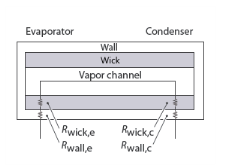

|
•
|
Rwall,e the thermal resistance of the wall on evaporator side
|
|
•
|
Rwick,e the thermal resistance of the wick on evaporator side
|
|
•
|
Rlv,e the thermal resistance of the liquid-vapor interface on evaporator side
|
|
•
|
Rlv,c the thermal resistance of the liquid-vapor interface on condenser side
|
|
•
|
Rwick,c the thermal resistance of the wick on condenser side
|
|
•
|
Rwall,c the thermal resistance of the wall on condenser side
|
|
•
|
Rv,a the thermal resistance of the vapor channel in adiabatic section
|
|
•
|
Rwick,a the thermal resistance of the wick in adiabatic section
|
|
•
|
Rwall,a the thermal resistance of the wall in adiabatic section
|